Calculation of the area of ducts and fittings: rules for performing calculations + examples of calculations by formulas
The key to perfect and effective ventilation is the competent calculation of the area of ducts and fittings, on which the selection of both individual elements and equipment depends. The purpose of the calculation is to ensure the optimal multiplicity of air changes in the premises in accordance with their purpose.
In the article, we examined in detail each of the required stages of the calculations: determining the cross-section and the actual area of the air ducts, calculating the air speed and selecting the parameters of the shaped products. In addition, we identified the main requirements for the size of ventilation ducts, and also gave an example of the calculation of air ducts for a private house.
The content of the article:
The purpose of the calculations
Features of the calculation and duct selection depend on their type and the material from which they are made. The latter characteristic determines the nuances arising from the movement of air and the features of the interaction of an avalanche of air with the walls.
Ducts are:
- metal - it can be black steel, galvanized, stainless steel;
- flexible aluminum corrugated;
- plastic ventilation ducts - flexible and rigid;
- tissue.
According to the geometry of the section, round, rectangular, oval ducts are made. The latter are not as popular as the first two.
Even if there is the most correct design of the ventilation system, an error in the selection of cross-sections of the ducts can lead to disruption of air circulation.
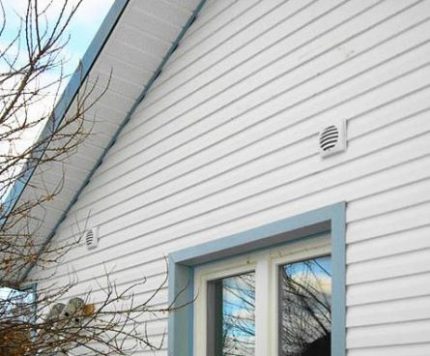
Depends on this parameter:
- air mass flow rate and its volume;
- degree of tightness of the joints;
- noise of the ventilation system;
- power consumption.
Correct calculations will save money because the amount of material will be determined accurately. But in addition to economic issues, the main ones are still ventilation parameters that provide comfortable living conditions for people.
General information for calculating cross-sectional area
The area of the pipes for the duct is calculated according to different values:
- For compliance with sanitary and hygienic parameters (SanPiN).
- By the number of residents.
- By the area of the rooms.
The result can be obtained both for a separate room, and for the house as a whole. For calculation, there are special programs with algorithms embedded in them. Another calculation option is the use of formulas.
The cross-sectional area of the ducts during their design is chosen so that the air along all lengths moves with approximately the same speed. Throughout the length of the system, the amount of air is different, so the cross-sectional area of the duct should change upward with increasing air volume.
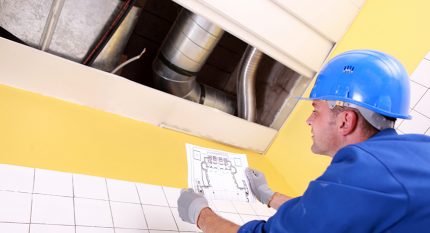
With the growth of a circular cross section, the air flow rate decreases. At the same time, aerodynamic noise will also be reduced. The disadvantage of such ducts is the bulkiness of the structure, because of which it is impossible to install them in the space between the draft and suspended ceilings, as well as at an increased cost.
If this is not possible, you can give preference to rectangular geometry, since the height of the rectangular section is less. On the other hand, round products are easier to install, and they have their own operational advantages.

The choice of one or another option depends on the user's priorities. If at the forefront is energy saving, minimal noise and there are all the possibilities of installing a dimensional network, the best choice is the round shape of the duct.
Calculation Stages
Settlement work consists of several stages:
- Drawing up a common ventilation system diagrams. Here, the lengths of the straight sections, the turning parts and their type, the places of change of the section should be noted.
- The choice of the multiplicity of air exchange, identical to sanitary and hygienic requirements.
- The calculation of the speed of movement of air masses through the pipeline. This parameter depends on type of ventilation, and it can be natural or forced.
- Calculation of the area of ducts and other parameters.
There are many programs for performing such calculations.
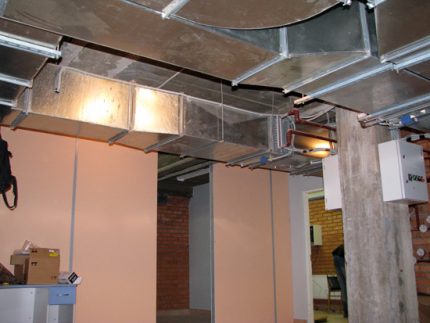
The calculation of the cross section of the duct
The expression used to calculate the quadrature of the shaped elements and ducts looks like this:
Sc = (L x 2.778): V,
Where:
- Sc - area in cross section;
- L - flow rate of air circulating in the system;
- 2.778 - coefficient matching various dimensions;
- V - The speed of an avalanche in a particular place, measured in meters per second.
The result of the calculation will be a value measured in cm².
There is an alternative formula:
S = L: k × V,
The coefficient K in this case is 3600.
Determining the actual duct area
The regular ventilation area for round ventilation ducts is calculated by the formula:
S = (π x D2): 400,
Where:
- S - actual area;
- D - diameter.
For rectangular pipelines:
S = (A x B): 100,
Where:
- S - actual area;
- D - diameter;
- AND - duct height;
- AT - width of the structure.
The cross-sectional area for a pipe with an oval cross-section is calculated by the formula:
S = π × A × B: 4,
Where:
- AND - the larger diameter of the oval;
- AT - smaller diameter, respectively.
There are other formulas for calculating the duct area.
Using such a regulatory document as SNiP, you can compare the size of the cross-sections of the ducts with the required indicators. Thus, the suitable size of the air pipe is determined even more simply.
Some manufacturers in the description of the ducts give nomograms. They are in the regulatory literature.
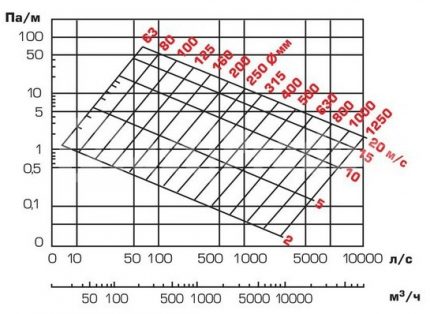
From nomograms you can take the value of the cross-sectional area. It is approximate, but suitable for creating a system with minimal noise.
To find the dimensions of the duct for a particular branch of the pipeline through which a given volume of air is transported, you must perform the following steps:
- Determine on the nomogram the point of intersection of the volume of air transported in 1 hour and the line of maximum speed for the calculated section.
- Next to this point, find the value of the most suitable diameter.
In addition, having a nomogram, it is possible not only to facilitate the calculation of the cross section of air ducts and fittings, but also to specify the pressure loss over a section of the air line at a set speed.
The nomogram is optional; you can determine the desired cross-sectional area depending on the speed of the air mass.
Air velocity calculation
Using formulas or special tables, calculate the speed of the duct. The key parameter here is the multiplicity indicator, which determines the amount of air at which there is a full ventilation of a room with a volume of 1 m3 within 1 hour.
Experts recommend, to determine the rate indicator, to study specific conditions at existing industrial facilities, for which there is actual data on the emission of gases, toxic fumes, etc. It is best to do an independent calculation using the formulas.
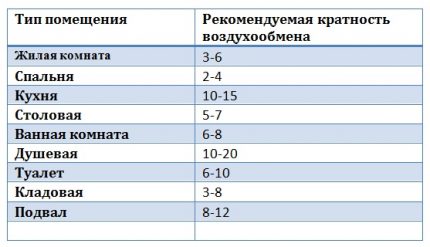
The formula for calculating the multiplicity is as follows:
N = V: W,
Where:
- N - desired multiplicity;
- V - the volume of fresh air mass entering the room within an hour;
- W - the volume of the room.
The unit of multiplicity is the number of times / hour, V is measured in mᶾ / h, the volume is in mᶾ.
Consider a specific example of determining the required amount of air by multiplicity.
There is a living room with a volume of 22 mᶾ. It will require air: L = 22 x 6 = 132 m3, here 6 is the air exchange rate taken from the table.
The velocity of the mass (V) is measured in m / s and determined by the formula:
V = L: 3600 x S,
Where:
- L - used air (mᶾ / h);
- S - sectional duct area (mᶾ).
In addition, 2 more parameters affect air speed: noise level, vibration coefficient. When designing a system, they must be taken into account.
Calculation example for a small cottage
For the calculation we took a cottage with an internal area of 108.8 m2 and a height of 3 m from the floor to the ceiling. Inside there is a living room, bedroom, children’s room, kitchen, bathroom. The multiplicity index is taken equal to 1.

First, the amount of removed and incoming air in general for the building is calculated.
Apply for this method SNiP:
- Since the bedroom and living room are the same in area, the amount of air removed from them is 21 x 3 x 1 = 63 mᶾ / h.
- For children - 24 x 3 x 1 = 72 mᶾ / h.
- For the kitchen - 22 x 3 x 1 + 100 = 166 mᶾ / h.
- For the bathroom - 10 x 3 x 1 = 30 mᶾ / h.
- As a result: 63 x 2 + 48 + 166 + 30 = 394 mᶾ / h.
The corridor and the hallway were not taken into account.100 mᶾ is the volume that goes through the hood in the kitchen.
The correct distribution of air flow in the house is also a very important point. In buildings of this type, a natural ventilation system is usually arranged. The coercive element is still present here - cooker hood.
Next, determine the diameters of the ventilation ducts. Since 100 m3 removes the hood forcibly, it remains to distribute the remaining 294 m3. They will leave naturally through 2 mines. Each will have: 294: 2 = 147 mᶾ.
Since in the mines of natural ventilation the air speed ranges from 0.5 to 1.5 m / s, usually in calculations they take an average value of 1 m / s. Substituting the known values in the formula S = L: k × V, they find: S = 147: 3600 x 1 = 0.0408 m².
Now it is possible to determine the diameter of the duct with a circle in cross section according to the formula: S = (π x D2): 400 or 0.0408 = (3.14 x D2): 400.
Solving this equation with one unknown, through simple calculations, they find that the diameter of the duct is 2.28 mm. The closest larger standard pipe size is selected for this value.
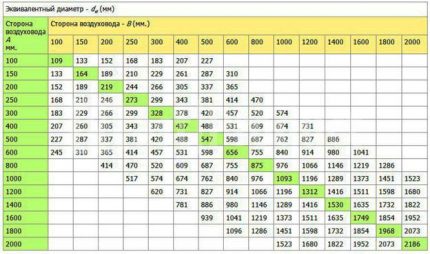
When a rectangular duct is mounted, its size is selected according to the table, focusing on the area. The closest larger value is 200 x 250 mm.
According to the same scheme, the cross-sectional area of the tap for a cooker hood is determined with the difference that the air velocity here is 3 m / s. S = 100: 3600 x 3 = 0.083 m² or diameter 107 mm.
A conversion table is necessary when it is necessary to perform the calculation of air ducts with a rectangular cross section and apply the table for round products. Here are the diameters of air ducts with a circle in cross section, in which the decrease in pressure due to friction is equal to the same value in a rectangular design.
There are three ways to determine the equivalent value:
- by speed;
- along the cross section;
- by expense.
These values are associated with different duct parameters. For each of them there is an individual methodology for using tables. The main thing is that, regardless of the applied methodology, the magnitude of the loss of friction pressure is the same.
In conclusion, a speed check is carried out: V = 147: (3600 x 0.0408) = 1.0 m / s. This is within the acceptable limit.
Shaped products and their calculation
At duct installation straight sections of various sizes are connected using shaped products.
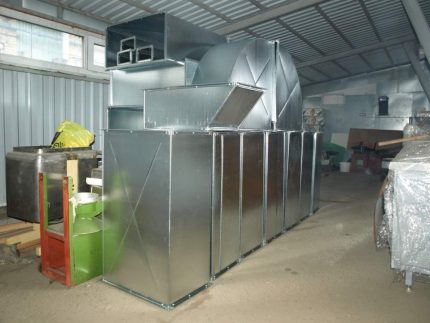
Shaped products include:
- Bends. They are used to change the direction of the air pipeline at every possible angle. There are both round and rectangular, oval.
- Transitions. With their help, ducts of various sections are connected. Any geometry - from round to combined.
- Couplings, nipples. Connect straight sections of the highway.
- Tees. Joint branches or two branches of the duct.
- Stubs. Block the air flow.
- Crosses. Separate or connect air streams.
- Ducks. Provide a multi-level passage of the duct.
To calculate the necessary parameters of shaped products, mathematical skills are needed.
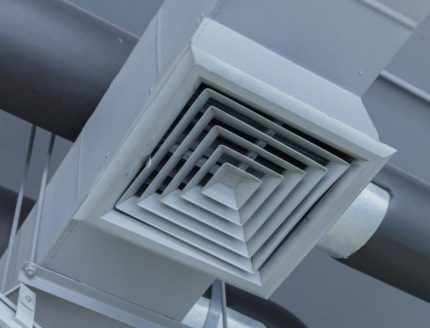
A mistake made in one indicator will entail a deterioration in the performance of the system. There are no ready-made formulas for such calculations.
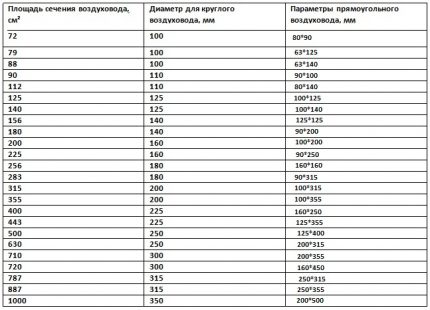
Many designers use special programs, online calculators. You only need to enter the primary values and get ready-made parameters at the output.
Programs allow not only to determine the necessary values of all parts, but also to make their development. This scan, printed on a 3D printer, makes it possible to perfectly fit the ventilation ducts.
Basic calculation requirements
When determining the final parameters of the ducts, it must be taken into account that determining the area of the ducts must ensure that:
- The temperature regime in the room is provided. Where there is an excess of heat, its removal is provided, and where there is a deficiency, its loss is minimized.
- The speed of air movement in no way reduces the level of comfort of people in the room. In areas of working areas, air purification is mandatory.
- Harmful chemical compounds and suspended particles present in the air are in the volume corresponding to GOST 12.1.005-88.
For individual rooms, a prerequisite for selecting the area of air ducts is the constant maintenance of backwater and the exclusion of air supply from the outside.
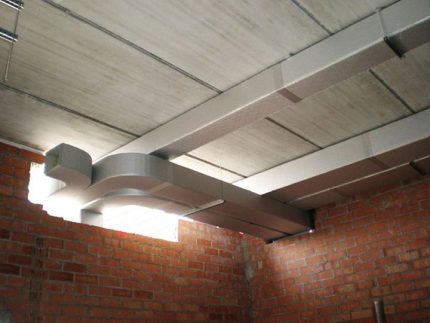
The category of premises where support is necessary includes basements, as well as rooms in which harmful substances can accumulate.
Conclusions and useful video on the topic
Online program to assist the design engineer:
The plot of the organization of ventilation of a private house as a whole:
The cross-sectional area, shape, length of the duct are some of the parameters that determine the performance of the ventilation system. Correct calculation is extremely important because the air throughput, as well as the flow rate and the effective operation of the structure as a whole, depend on it.
When using the online calculator, the degree of accuracy of the calculation will be higher than when calculating manually. This result is explained by the fact that the program automatically rounds off the values to more accurate ones.
Do you have personal experience in designing, arranging and designing a duct system? Want to share your knowledge or ask questions about the topic? Please leave comments and participate in discussions - the feedback form is located below.

 Calculation of air ducts for speed and flow rate + methods for measuring air flow in rooms
Calculation of air ducts for speed and flow rate + methods for measuring air flow in rooms 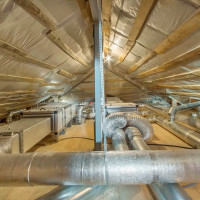 Private house ventilation standards: device requirements and calculation examples
Private house ventilation standards: device requirements and calculation examples 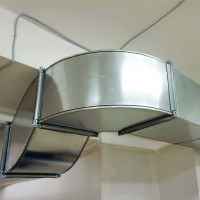 Duct mounting distance standards: calculation of the geometric data of the ventilation route
Duct mounting distance standards: calculation of the geometric data of the ventilation route  Norms of air exchange rate in various rooms + calculation examples
Norms of air exchange rate in various rooms + calculation examples  How to calculate humidity on a hygrometer: a manual for the use of devices + calculation examples
How to calculate humidity on a hygrometer: a manual for the use of devices + calculation examples 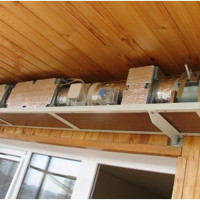 How to make a ventilation calculation: formulas and an example of calculating a supply and exhaust system
How to make a ventilation calculation: formulas and an example of calculating a supply and exhaust system  How much does it cost to connect gas to a private house: the price of organizing gas supply
How much does it cost to connect gas to a private house: the price of organizing gas supply  The best washing machines with dryer: model rating and customer tips
The best washing machines with dryer: model rating and customer tips  What is the color temperature of light and the nuances of choosing the temperature of the lamps to suit your needs
What is the color temperature of light and the nuances of choosing the temperature of the lamps to suit your needs  Replacement of a geyser in an apartment: replacement paperwork + basic norms and requirements
Replacement of a geyser in an apartment: replacement paperwork + basic norms and requirements